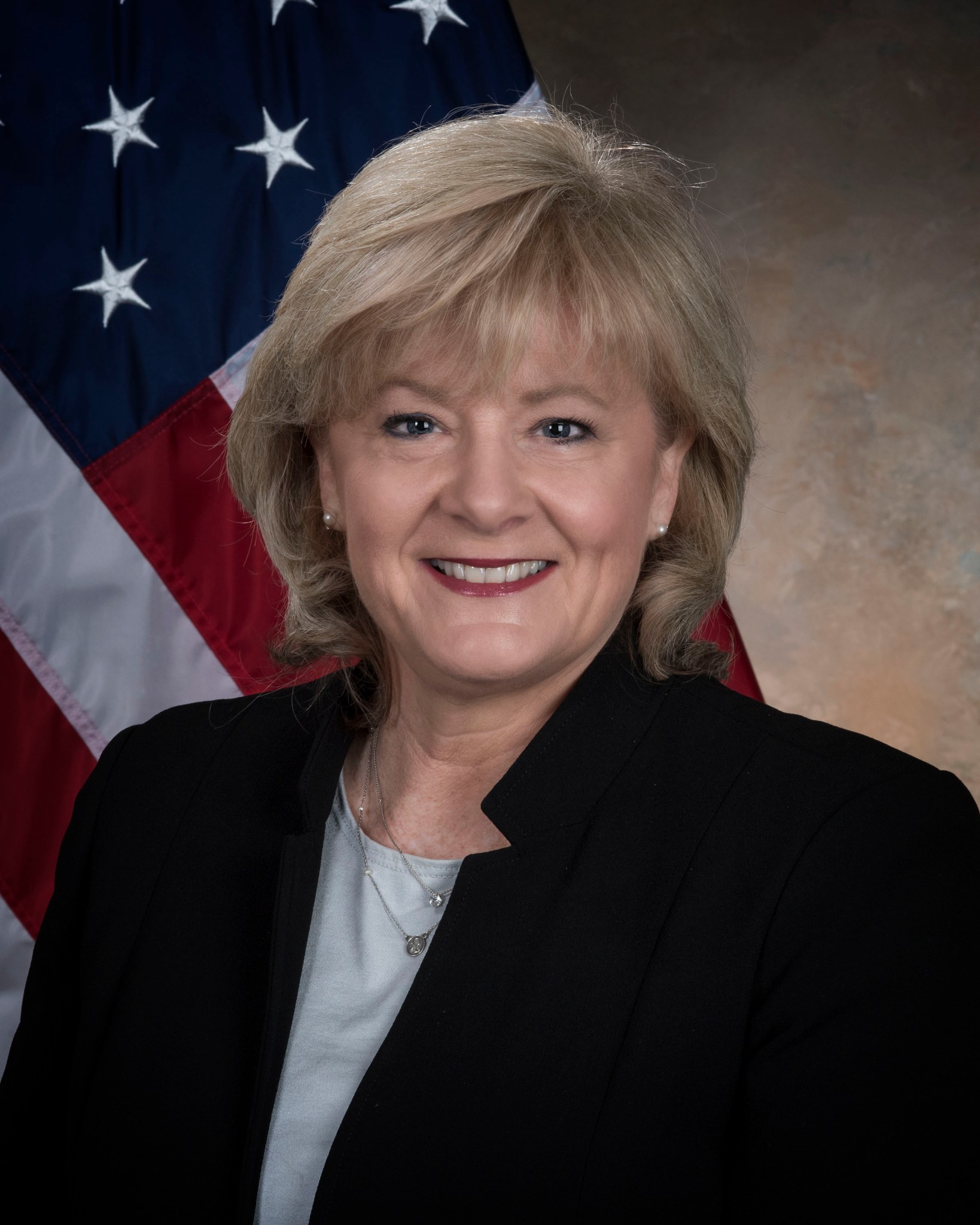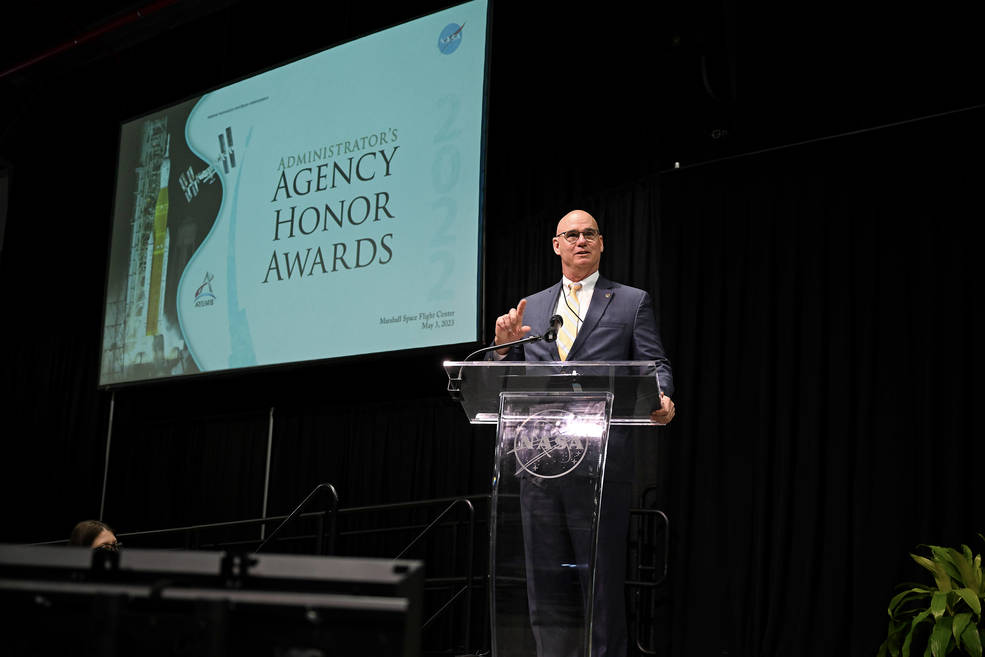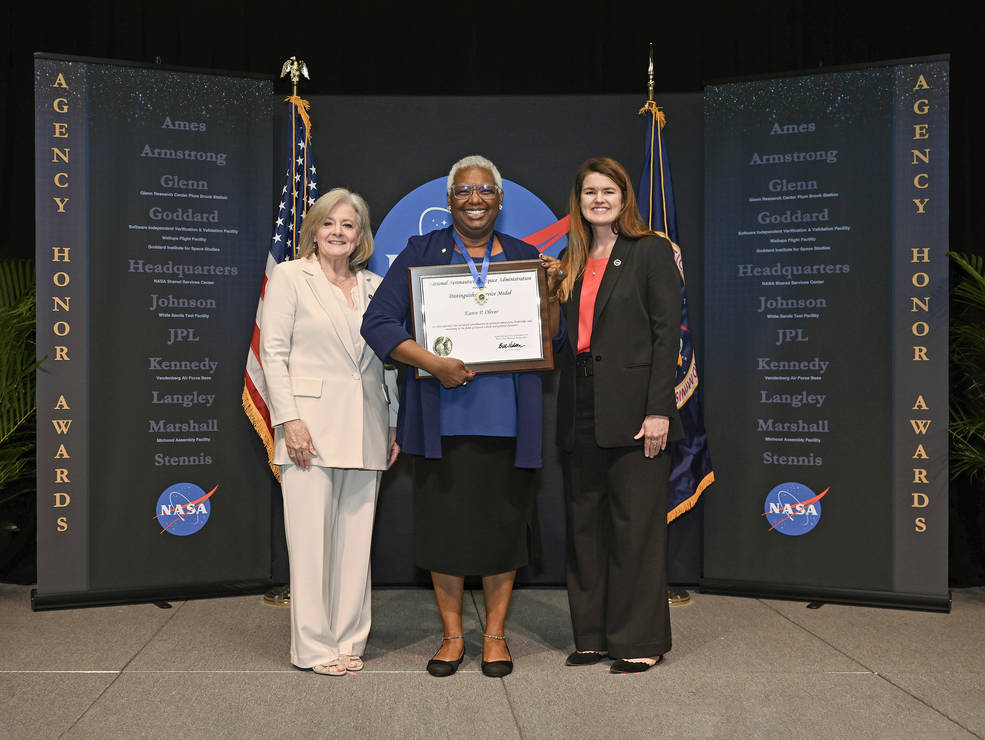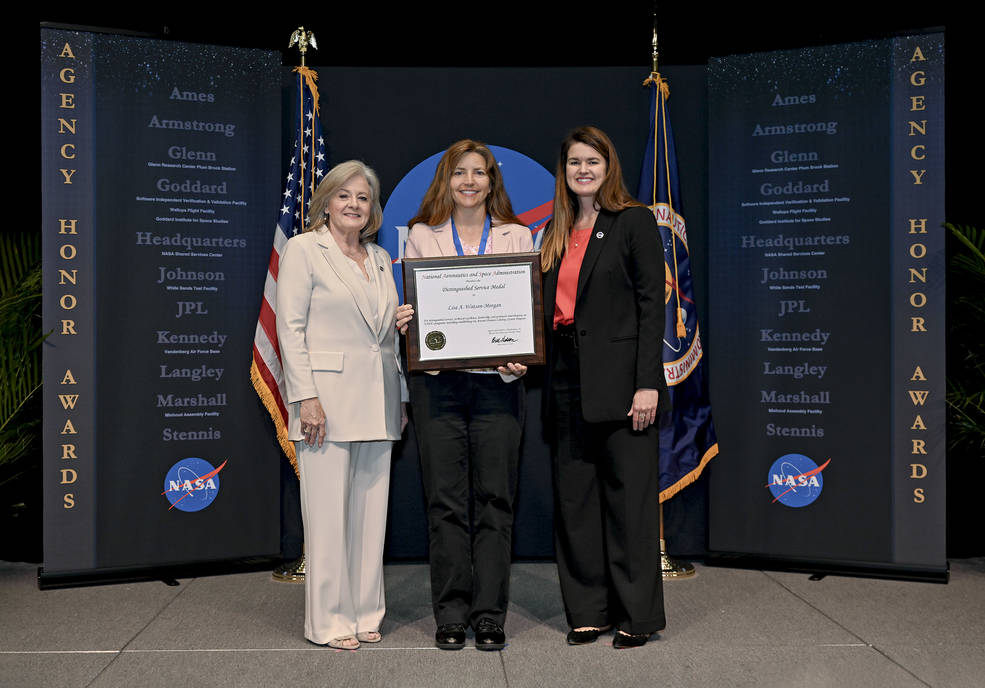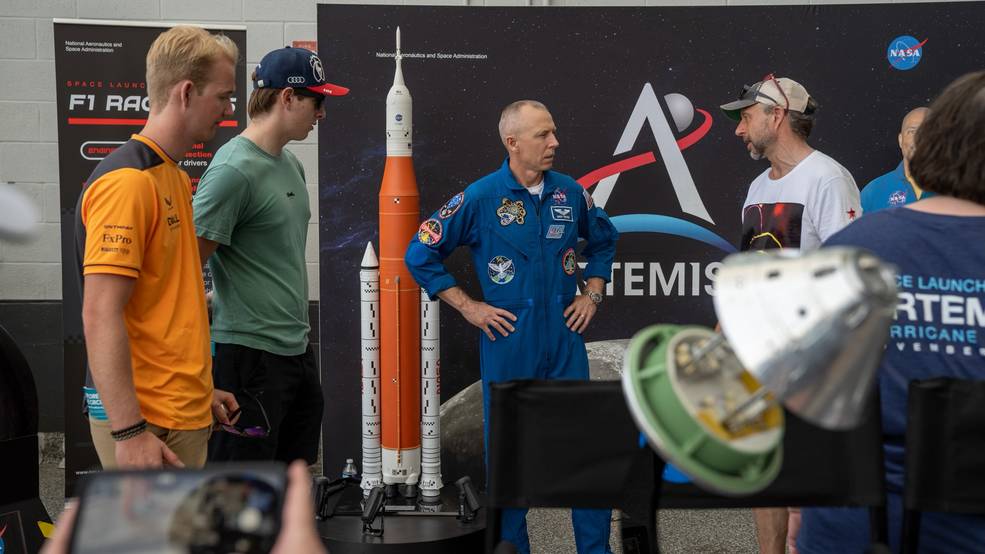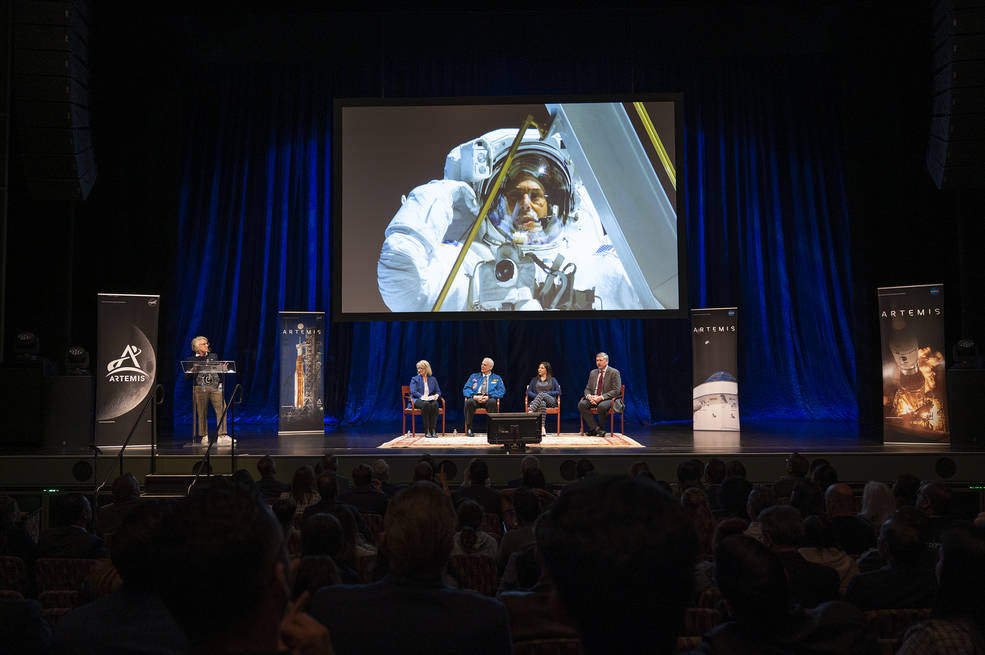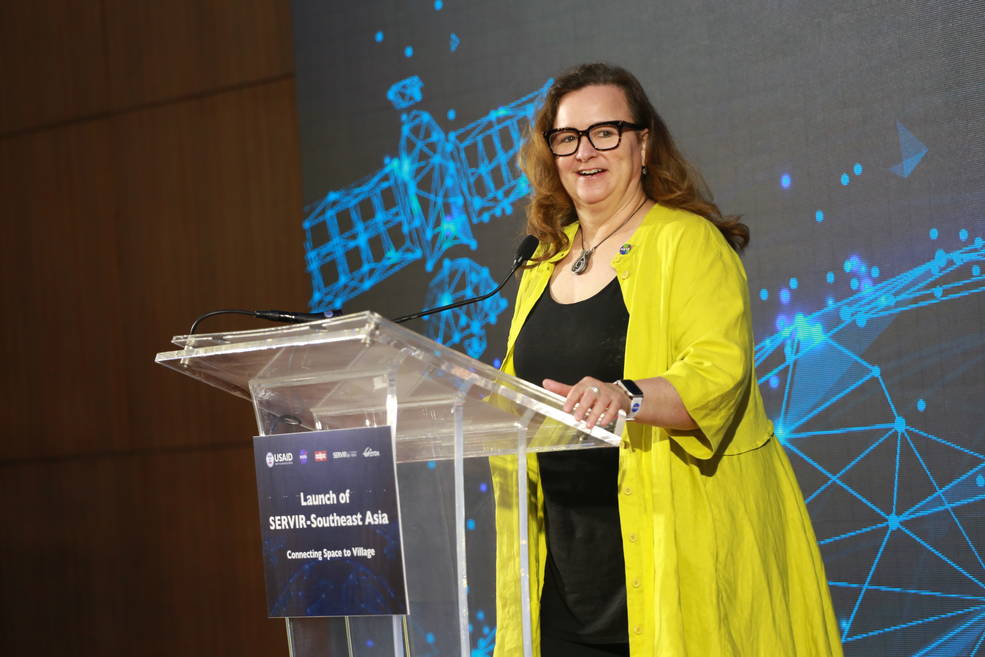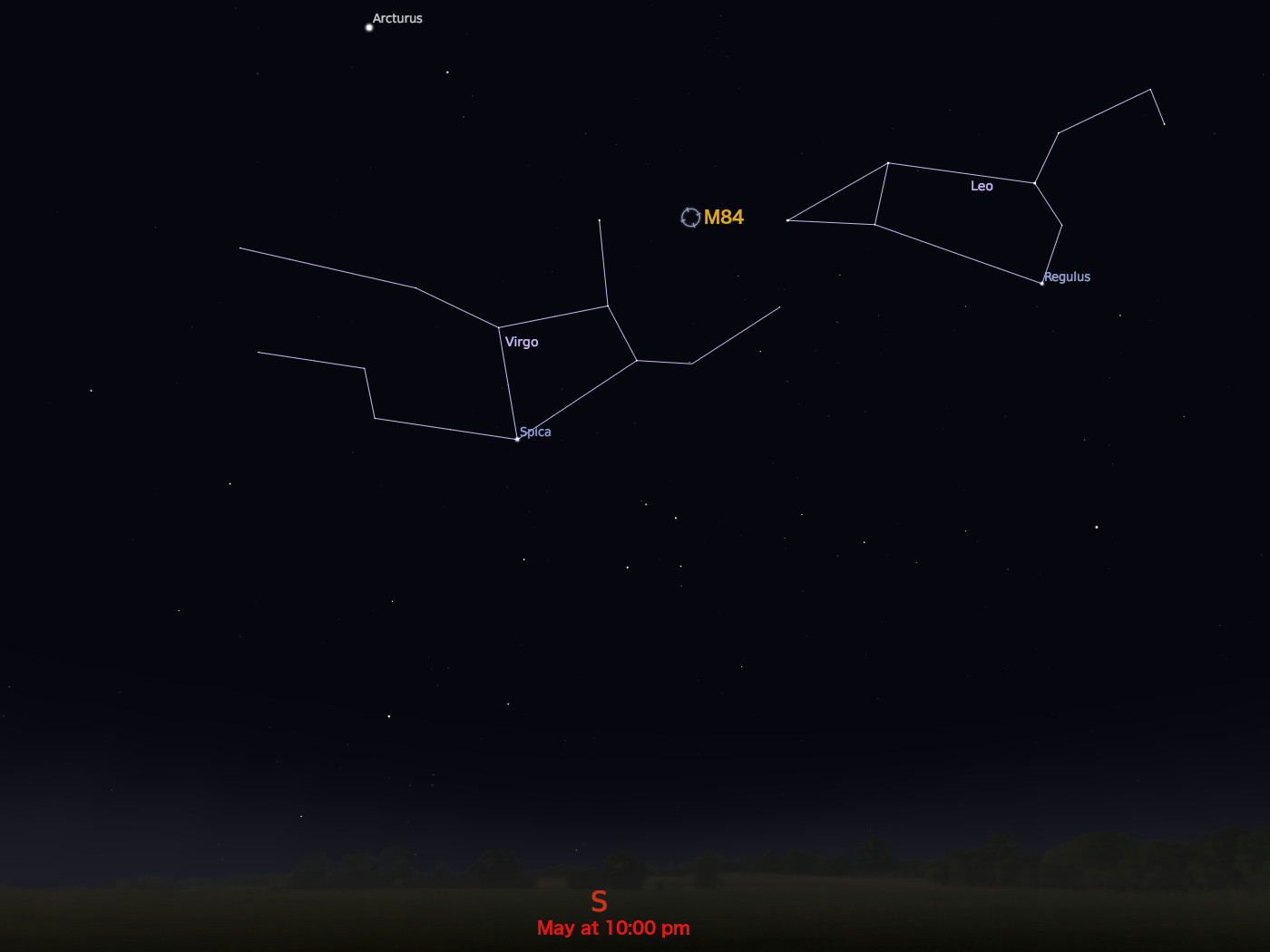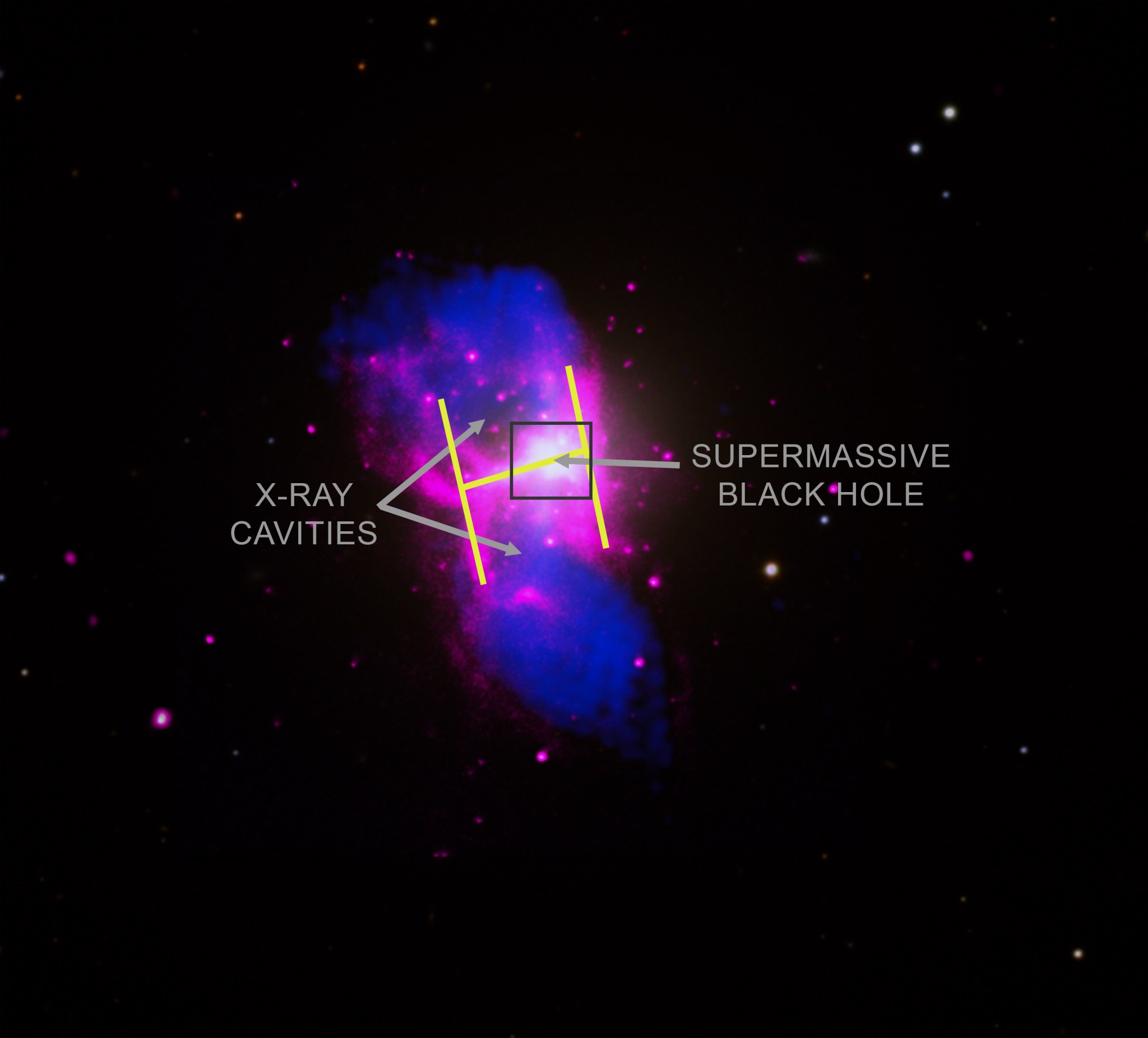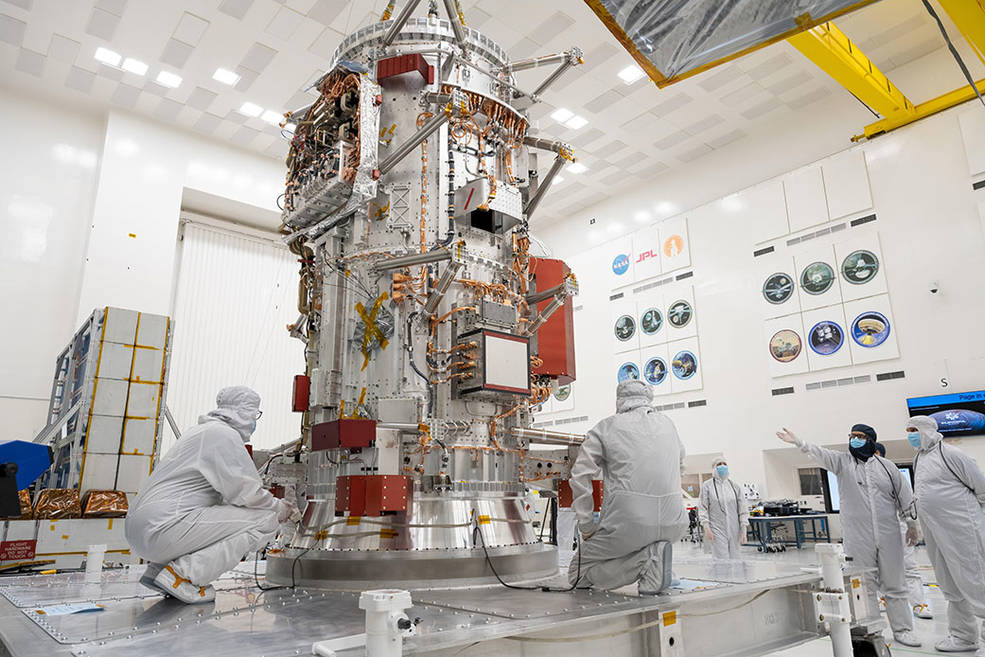The Marshall Star for May 10, 2023.
In This Week’s Star
- May 16 All Hands: Marshall AT Work
- Marshall Hosts Administrator’s Agency Honor Awards
- NASA Astronaut, SLS Employees Attend Miami Grand Prix
- NASA, Industry Partners Recognize California’s Contributions to Artemis
- Satellite Data, Applications Flowing Through SERVIR to Southeast Asia
- ‘H’ is for Hot and Huge in Chandra Image
- New Video Series Captures Team Working on NASA’s Europa Clipper
- Webb’s Promising Find Featured on ‘This Week at NASA’
May 16 All Hands: Marshall AT Work
Marshall Team,
What an exciting year we have already had at NASA and Marshall Space Flight Center, from celebrating the successes of Artemis I to last week’s visit from the Crew-5 astronauts! I know there is much more to come in 2023 and beyond.
I invite you to join Marshall’s leadership team May 16 at 10 a.m. for a hybrid All Hands meeting. We will meet in person at the Marshall Activities Building 4316, and on the NASA Townhall platform. We will discuss the end of the COVID National Health Emergency and what that means for how we work at Marshall.
You may submit Marshall work experience questions here for us to answer during the All Hands meeting. You can submit questions through May 10. We will address the top themes from your questions as time permits during the All Hands and take questions from the audience.
Please look for further communications about how to join the All Hands in person and online. Thank you for all that you do to advance NASA’s mission and keep Marshall the best place to work in Alabama.
Jody
Marshall Hosts Administrator’s Agency Honor Awards
Bill Marks, deputy director of center operations at Marshall Space Flight Center, welcomes guests to the 2022 Administrator’s Agency Honor Awards, which were held May 3 in Marshall’s Activities Building 4316. Honorees from eight NASA centers and NASA Headquarters were recognized, including Rick Burt, Karen Oliver, and Dr. Lisa Watson-Morgan from Marshall. Each honoree received the Distinguished Service Medal or Distinguished Public Service Medal for their contributions and work in support of NASA’s mission. “It is a true privilege to host so many award recipients from across the agency,” Marshall Director Jody Singer said. “You, the workforce, are our true talent.” See the full list of honorees here. (NASA/Charles Beason)
Karen Oliver, center, displays her Distinguished Service Medal and award certificate while standing with Marshall Director Jody Singer, left, and NASA Deputy Associate Administrator Casey Swails. Oliver’s contributions to NASA include work as a leader, mentor, and technical innovator in the fields of launch vehicle and payload dynamics. (NASA/Charles Beason)
Dr. Lisa Watson-Morgan, center, displays her Distinguished Service Medal and award certificate while standing between Singer, left, and Swails. Watson-Morgan’s contributions to NASA include establishing the Artemis Human Landing System Program; leading thousands of civil servants and support contractors as deputy director of Marshall’s Engineering Directorate; and her current role as program manager for the HLS Program. “I am so humbled to be included in the honoree group, and it means a lot to be recognized,” Watson-Morgan said. “I am forever grateful for my many years of service at Marshall.” (NASA/Charles Beason)
NASA Astronaut, SLS Employees Attend Miami Grand Prix
NASA astronaut Drew Feustel and SLS (Space Launch System) employees from Marshall Space Flight Center interact with racegoers during the Miami Grand Prix race weekend May 6-8. Feustel is a veteran of three spaceflights, including the final servicing mission of NASA’s Hubble Space Telescope. The avid auto racing fan is a nine-time spacewalker and has logged 226 days in space throughout his career. Students and members of the public were invited to walk through the exhibit area to learn more about Artemis throughout race weekend. While there, NASA team members discussed the physics behind the SLS rocket that will power the Artemis missions to the Moon in comparison to the world-famous racecars. With Artemis, NASA will land the first woman and first person of color on the lunar surface and establish long-term exploration and science capabilities at the Moon in preparation for human missions to Mars. SLS and NASA’s Orion spacecraft, along with the human landing system and the Gateway in orbit around the Moon, are NASA’s foundation for deep space exploration. (NASA/Brandon Hancock)
NASA, Industry Partners Recognize California’s Contributions to Artemis
NASA, along with its Artemis industry contract partners, acknowledged dozens of businesses in Southern California May 2-4 for their contributions to the successful launch of the Artemis I mission, and their continued support for future crewed Artemis missions.
Each of the suppliers has played a role in manufacturing and producing key components for NASA’s SLS (Space Launch System) rocket and Orion spacecraft, including their propulsion systems and main structures. NASA’s Marshall Space Flight Center manages the SLS Program.
Following the debut of SLS and Orion during Artemis I in 2022, NASA and its industry partners are preparing for the second flight test – Artemis II – during which four astronauts will lift off atop the SLS mega Moon rocket and check out Orion’s systems during a lunar flyby before returning to Earth.
“The momentum for Artemis has only just begun, and California is making it possible,” said Jim Free, associate administrator for Exploration Systems Development at NASA Headquarters. “From launch to orbit to recovery, men and women across California can say their skills and expertise are enabling Artemis at every point as we work to send astronauts to explore a new region of the Moon and prepare for even more ambitious missions to Mars.”
SLS and Orion are part of the backbone for NASA’s deep space exploration goals under Artemis with businesses in all 50 states contributing to their production. With more than 500 companies and 16,000 people, more people in California work on Artemis than any other state.
Over the course of the three-day visit in the Golden State, NASA managers and NASA astronaut Lee Morin, along with managers from lead contracting partners Aerojet Rocketdyne, Boeing, Jacobs, Lockheed Martin, and Northrop Grumman, toured nine facilities and met with members of the workforce.
- Aerojet Rocketdyne in Canoga Park is the lead engines contractor for the SLS rocket. Its California facility managed upgrading and testing the 16 RS-25 engines remaining from NASA’s Space Shuttle Program to power the first four Artemis flights and is currently manufacturing 24 new RS-25 engines for SLS flights beginning with Artemis V.
- AMRO, Karman Space and Defense in South El Monte provides machining and welding services for multiple Artemis elements, including the primary structures for the SLS core stage, the Orion crew module, the launch abort system, and the forward skirt for future SLS solid rocket boosters.
- Beranek, LLC Precision Machining in Torrance is a small business that manufactures components for SLS.
- Kirkhill, Inc. in Santa Fe Springs manufactures an erosion-resistant rubber insulation that is applied at critical areas along SLS, including its solid rocket boosters and the launch abort system, to protect hardware from weather and extreme temperatures during launch and flight.
- LeFiell Manufacturing Company in Brea has nearly 9.2 miles of metallic tubing on the initial configuration of the SLS rocket, known as Block 1.
- Precision Aerospace in Rancho Cucamonga chemically mills several components for the RS-25 engines that help power the SLS rocket. At its one-of-a-kind chemical milling facility, each nozzle jacket for the RS-25 engine is milled down to its final thickness equal to about three sheets of paper.
- Precision Tube Bending in Santa Fe Springs manufactures custom bended tubes on all dry volumes, propellant tanks, system tunnel, and other specialty components on the SLS core stage as well as the tubing for each of the four RS-25 engines on SLS.
- VACCO Industries in El Monte manufactures specialty valves for the core stage’s two liquid propellant tanks as well as pre-valves, advanced cryogenic fluid control products, and quick disconnects.
- Votaw Precision Technologies in Santa Fe Springs specializes in producing large metal parts the SLS flight hardware. For Artemis I, it also fabricated the Orion crew module barrels.
An additional 21 businesses were recognized at a community event May 3 in Cerritos for their contributions to Artemis. The businesses provide welding and 3D engineering services, software development, security and safety services, as well as specialty small parts fabrication like valves, harnesses, clamps, batteries, and cables to support Artemis.
California is home to three NASA centers: Ames Research Center, Armstrong Flight Research Center, and Jet Propulsion Laboratory.
California had more than $15 billion in aerospace and defense exports in 2021. Additionally, Southern California native and NASA astronaut Victor Glover will serve as the pilot for the Artemis II mission.
With Artemis, NASA will land the first woman and first person of color on the lunar surface and establish long-term exploration for scientific discovery and to prepare for human missions to Mars. SLS and NASA’s Orion spacecraft, along with the human landing system and the Gateway in orbit around the Moon, are NASA’s foundation for deep space exploration.
Satellite Data, Applications Flowing Through SERVIR to Southeast Asia
More than 50 million people in Vietnam, Cambodia, Thailand, Laos, and Myanmar draw water for drinking and agriculture from the Mekong River. With customized tools that use NASA observations and data, the people who manage that water supply have been improving their decision-making. It is a prime example of the work NASA and the U.S. Agency for International Development (USAID) have been doing to make Earth data more accessible and useful in countries around the world.
Historically, reservoir measurements or flood warnings along the Mekong River came from stream gauges and limited or outdated satellite data, said Anoulak Kittikhoun, CEO of the intergovernmental Mekong River Commission. But in recent years, scientists in the region have worked with colleagues from NASA, USAID, and the Asian Disaster Preparedness Center (ADPC) to build tools that process data from Earth-observing satellites and better predict extreme rainfall and track reservoir levels.
“Our collaboration enhanced the accuracy and lead time of the Mekong River Commission’s flood forecasting,” Kittikhoun said. “As climate change intensifies and development accelerates, we will work together to get better information into the hands of farmers and communities in order to make them more resilient and adaptable.”
The work springs out of SERVIR, an initiative first launched in 2004 by NASA and USAID. With a name derived from the Spanish word “to serve,” SERVIR builds collaborative projects and conducts training to help bring Earth data into regional, national, and local decision-making. Working with scientists and agencies around the world, SERVIR has established five science hubs scattered across Asia, Africa, and Latin America.
“Collaborative development leads to geospatial services that fit community needs,” said Karen St. Germain, director of NASA’s Earth Sciences Division at NASA Headquarters. “The approach creates an environment where teams learn from one another. This fosters a stronger, more inclusive approach to Earth science – accelerating discovery and uptake of that science.”
The Mekong water-observing tools were developed through the SERVIR-Mekong program, which was founded in 2014 with ADPC in Thailand. A series of positive collaborations inspired the partners to expand their work in the region with the renamed SERVIR-Southeast Asia.
“We made such an impact in recent years as SERVIR-Mekong, and I’m excited about being able to work alongside more partners to enable their use of NASA’s Earth science to address their most pressing environmental issues,” said Nancy Searby, NASA’s Earth Sciences program manager responsible for SERVIR. “While there are unique concerns in each place, our data, methods, and services can be tailored to address those needs.”
Beyond the river-monitoring tools, scientists affiliated with the program also created a tool to automatically interpret atmospheric data from NASA satellites and share it through Thailand’s Pollution Control Department. Named the Mekong Air Quality Explorer, the tool includes a mobile app that authorities use to identify sources of heavy smoke and pollution, track air flow, and help officials send out public health warnings about poor air quality. The World Health Organization estimates that pollution leads to as many as 2 million premature deaths per year in Southeast Asia.
In a January 2023 ceremony marking the expansion of SERVIR Southeast Asia, project leaders described some of the new geospatial services they will offer, such as tools for tracking forest loss and for helping the rice growers prepare for climate change. The new hub also will expand its range across borders and into countries like Indonesia and the Philippines.
The key to SERVIR’s work in Asia and elsewhere is that the best partnerships grow out of dialogue and exchanges of ideas, not one-sided conversations. U.S. researchers are actively encouraged to ask what partners might need and how they can work alongside them to co-develop solutions, rather than just flooding colleagues with data.
“The Air Quality Explorer that was adopted by Thailand will be scaled up to address transboundary haze issues between Thailand and Laos, and eventually across Southeast Asia,” said Peeranan Towashiraporn, SERVIR-Southeast Asia’s chief of party. “Similarly, the satellite-based tools for monitoring of flood and drought, successfully adopted by the Mekong River Commission, will be scaled out to support early warning systems in other countries in the region.”
The SERVIR program, jointly led by NASA and USAID, is operated by the Earth Science Division‘s Applied Sciences Program in NASA’s Science Mission Directorate. Marshall Space Flight Center is home to the SERVIR Science Coordination Office (SCO). Marshall is supported on the program by four other NASA field centers: Goddard Space Flight Center; the Jet Propulsion Laboratory; Ames Research Center; and Langley Research Center.
‘H’ is for Hot and Huge in Chandra Image
With a single letter seemingly etched in the X-ray glow around it, a giant black hole at the center of a massive elliptical galaxy is making a mark on its surroundings.
This “H”-shaped structure is found in a detailed new X-ray map of the multimillion-degree gas around the galaxy Messier 84 (M84).
As gas is captured by the gravitational force of the black hole, some of it will fall into the abyss, never to be seen again. Some of the gas, however, avoids this fate and instead gets blasted away from the black hole in the form of jets of particles. These jets can push out cavities, in the hot gas surrounding the black hole. Given the orientation of the jets to Earth and the profile of the hot gas, the cavities in M84 form what appears to resemble the letter “H.” The H-shaped structure in the gas is an example of pareidolia, which is when people see familiar shapes or patterns in random data. Pareidolia can occur in all kinds of data from clouds to rocks and astronomical images.
Astronomers used NASA’s Chandra X-ray Observatory to make a map of the hot gas (pink) in and around M84, reaching to within only about 100 light-years away from the black hole in the center of the galaxy. This gas radiates at temperatures in the tens of millions of degrees, making it primarily observable in X-rays. The huge letter “H” is about 40,000 light-years tall – about half the width of the Milky Way. The radio image from the National Science Foundation’s Karl G. Jansky Very Large Array (VLA) (blue) reveals the jets streaking away from the black hole. Optical data from the Sloan Digital Sky Survey (white) shows M84 and neighboring galaxies. The letter H and the position of the black hole are labeled. An additional graphic shows a close-up of the region marked with a square, and separate labels for the galaxy and the jets in the optical and radio images respectively.
Researchers studying M84 with Chandra and the VLA found that the jets may influence the flow of the hot gas towards the black hole even more than the gravitational pull from the black hole. For example, the team estimates matter is falling towards the black hole from the north – along the direction of the jet seen in radio waves – at about 500 times the mass of the Earth every year, a rate that is only a quarter of that from directions where the jet is not pointing, to the east and west. One possibility is that gas is lifted along the direction of the jet by the cavities, slowing the rate at which gas falls onto the black hole.
The authors tested a model called Bondi accretion, where all of the matter within a certain distance from a black hole – effectively inside a sphere – is close enough to be affected by a black hole’s gravity and start falling inwards at the same rate from all directions. (The dashed circle in the close-up image is centered on the black hole and shows the approximate distance from the black hole where gas should start falling inwards.) This effect is named after the scientist Hermann Bondi, and “accretion” refers to matter falling toward the black hole. The new results show that Bondi accretion is not occurring in M84 because matter is not falling towards the black hole evenly from all directions.
M84 is a cousin of Messier 87 (M87), the galaxy containing the first black hole imaged with the global Event Horizon Telescope network, and, like M87, is also a member of the Virgo Cluster. The supermassive black hole in M84, along with those in our galaxy, M87, NGC 3115, and NGC 1600, are the only ones close enough to Earth, or massive enough, for astronomers to see details in Chandra images which are so near the black hole that gas should be falling inwards. Like the black hole in M87, the one in M84 is producing a jet of particles; however, the point source of X-rays from material even closer to the black hole is over ten times fainter for M84. This allows more detailed study of gas falling towards the black hole in M84 that is farther out, preventing the faint X-rays produced by this gas from being overwhelmed by the X-ray glare from the point source.
A paper describing these results appears in The Monthly Notices of the Royal Astronomical Society and a preprint is available here. The study was led by Christopher Bambic, a graduate student at Princeton University. Other authors include Helen Russell (University of Nottingham, United Kingdom), Christopher Reynolds (Institute of Astronomy, Cambridge, UK; University of Maryland, College Park), Andy Fabian (Institute of Astronomy), Brian McNamara (University of Waterloo, Canada; Waterloo Centre for Astrophysics, Canada), and Paul Nulsen (Center for Astrophysics | Harvard & Smithsonian).
NASA’s Marshall Space Flight Center manages the Chandra program. The Smithsonian Astrophysical Observatory’s Chandra X-ray Center controls science operations from Cambridge, Massachusetts, and flight operations from Burlington, Massachusetts.
New Video Series Captures Team Working on NASA’s Europa Clipper
Destined for Jupiter’s icy moon Europa, the Europa Clipper spacecraft – the largest NASA has ever flown on an interplanetary mission – is being readied to launch in October 2024. Between now and then, thousands of hours of work will go into assembling and testing the spacecraft to ensure it’s hardy enough to survive a six-year 1.6-billion-mile journey and sophisticated enough to perform a detailed science investigation of this mysterious moon.
The new video series “Spacecraft Makers: Europa Clipper” offers quick updates on the mission’s progress and lifts the curtain on the exacting work that goes into making sure the spacecraft reaches the Jupiter system in 2030. Europa Clipper aims to help answer questions about the ocean that scientists strongly believe lies below Europa’s icy crust.
The spacecraft will fly by the moon about 50 times while orbiting Jupiter. (It can’t orbit Europa because doing so would bring Europa Clipper too close to the gas giant’s brutal radiation belts. Learn more in the video.) On each flyby, a suite of science instruments will gather data on the depth of the subsurface ocean, the thickness of the ice crust, and, potentially, the characteristics of any plumes that may be venting subsurface water into space. The goal is to find out whether Europa has the potential to support life.
The series’ premiere episode features Europa Clipper Project Manager Jordan Evans, who also has worked on NASA’s Curiosity Mars rover and the agency’s Hubble Space Telescope. In the video, he joins Deputy Science Manager Trina Ray, who worked on NASA’s Cassini and Galileo missions. They venture into Jet Propulsion Laboratory’s (JPL) storied High Bay 1 clean room, where Europa Clipper is under construction – and where all of NASA’s Mars rovers, the twin Voyager spacecraft, and other historic spacecraft were assembled.
While you’re digging into the nuts and bolts of the spacecraft, check out a 24-hour live feed of assembly in progress in High Bay 1.
Additional episodes of “Spacecraft Makers” will include more activity inside other clean rooms where components of Europa Clipper are coming together. Future seasons of the series will cover other missions under construction at JPL.
Europa Clipper’s main science goal is to determine whether there are places below the surface of Jupiter’s icy moon, Europa, that could support life. The mission’s three main science objectives are to understand the nature of the ice shell and the ocean beneath it, along with the moon’s composition and geology. The mission’s detailed exploration of Europa will help scientists better understand the astrobiological potential for habitable worlds beyond our planet.
Managed by Caltech in Pasadena, California, JPL leads the development of the Europa Clipper mission in partnership with the Johns Hopkins Applied Physics Laboratory (APL) in Laurel, Maryland, for NASA’s Science Mission Directorate. APL designed the main spacecraft body in collaboration with JPL and NASA’s Goddard Space Flight Center. The Planetary Missions Program Office at NASA’s Marshall Space Flight Center executes program management of the Europa Clipper mission.
Webb’s Promising Find Featured on ‘This Week at NASA’
A promising find by NASA’s James Webb Space Telescope outside our solar system is featured in “This Week @ NASA,” a weekly video program broadcast on NASA-TV and posted online.
Webb detected hints of water vapor while observing GJ 486 b, an extremely hot rocky exoplanet that is too close to its star to potentially have liquid water. But astronomers don’t know yet if the water vapor is associated with the planet or its sun. If it is the former, that would indicate the planet has an atmosphere. To date, there has been no definite detection of an atmosphere around a rocky planet outside our solar system.
Webb is an international program led by NASA with its partners, ESA (European Space Agency) and the Canadian Space Agency. Several NASA centers contributed to the project, including NASA’s Marshall Space Flight Center.
View this and previous episodes at “This Week @NASA” on NASA’s YouTube page.


























